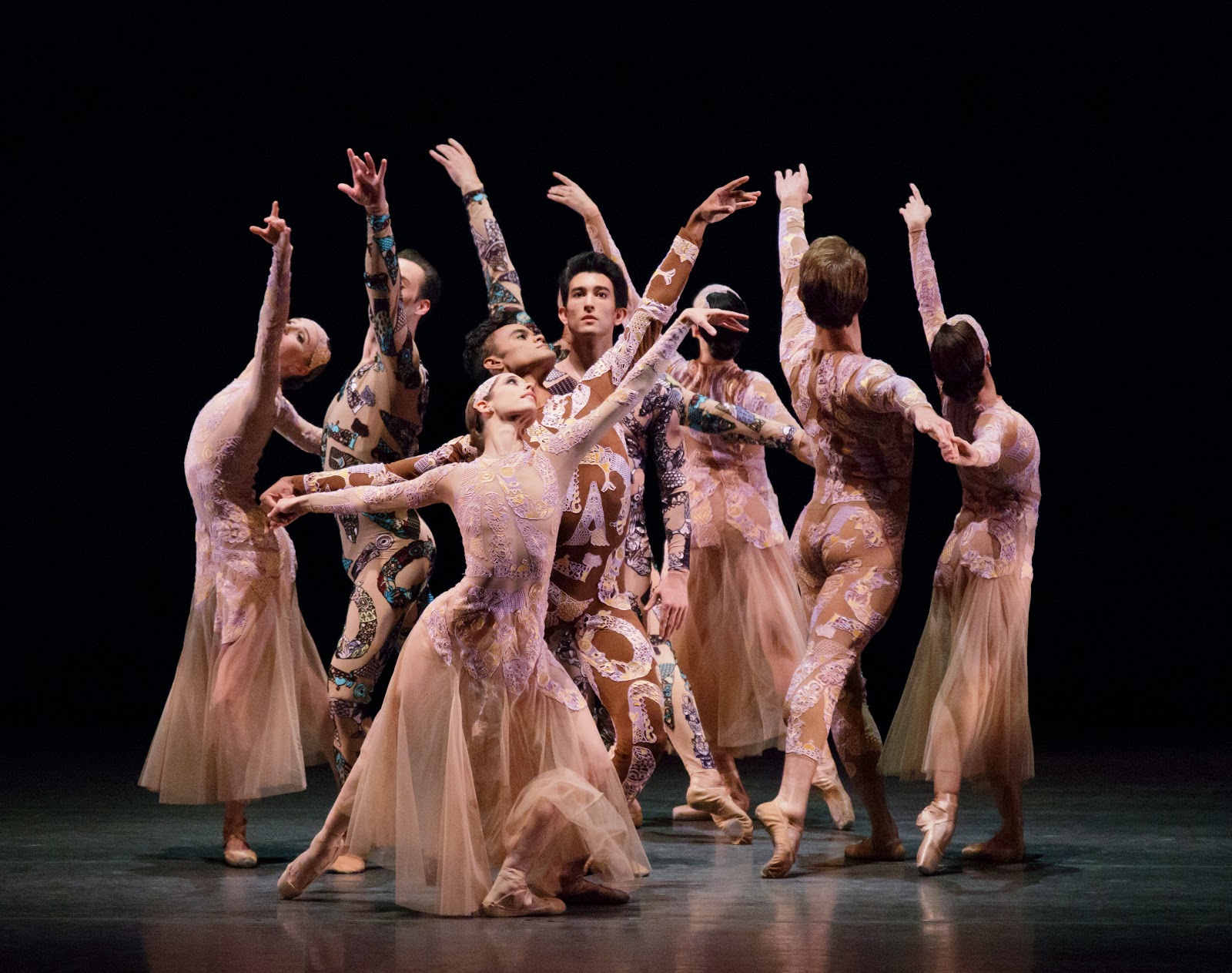THURSDAY EVENING, OCTOBER 9, 7:30 PM
MORGEN: *Reichlen, *Isaacs, *Krohn, *Catazaro, *Finlay, *Janzen [Conductor: Sill, Guest Soprano: Jennifer Zetlan]
CLEARING DAWN (New Greenstein/Schumacher): Bouder, Reichlen, Kretzschmar, Pazcoguin, Veyette, Prottas
pause
FUNÉRAILLES (New Liszt/Scarlett): T. Peck, R. Fairchild [Solo Piano: Chelton]
pause
BELLES-LETTRES (New Franck/Peck): Krohn, Lovette, Laracey, Pollack, J. Angle, Danchig-Waring, T. Angle, Stanley, Huxley [Conductor: Capps; Solo Piano: Walters]
PICTURES AT AN EXHIBITION (New Ratmansky/Music by Modest Mussorgsky): Mearns, T. Peck, A. Stafford, Whelan, Smith, T. Angle, Danchig-Waring, Garcia, Ramasar, Gordon [Solo Piano: Grant]
Peter Martins' 'Morgen' started the evening. Choreographed to 10 songs for soprano and orchestra by Richard Strauss, it is basically six dancers in search of a ballet. There is a succession of nine pas de deux, as each of the three women dances with each of the three men among a grouping of five Doric columns, followed by a final coming together of all six dancers as dawn breaks over the temple ruins.
 |
| The opening night cast in Peter Martins' 'Morgen' with new costumes by Carolina Herrera. Photo by Paul Kolnik for NYC Ballet |
The soprano, Jennifer Zetlan, shrill and distracting, seemed ill-suited to the Strauss material, which itself seems ill-suited for dance. The new costumes by Carolina Herrera, however, look lovely on the women and move easily.
Troy Schumacher's new ballet, 'Clearing Dawn', uses music by Judd Greenstein played by a chamber sextet. Troy uses a sextet of dancers (four women and two men) costumed by Thom Browne in chic grey, black and white prep school style uniforms. The costumes were too tight, unfortunately restricting the dancers freedom of movement.
 |
| Andrew Veyette being fitted for his costume in 'Clearing Dawn' in the NYC Ballet costume shop while Thom Browne looks on. Photo by Matt Bockelman for NYTimes |
 |
| Georgina Pazcoguin, Ashley Bouder, Claire Kretzschmar, Andrew Veyette, David Prottas and Teresa Reichlen in Troy Schumacher's 'Clearing Dawn'. Photo by Paul Kolnik for NYC Ballet |
 |
| Tiler Peck and Robert Fairchild costumed by Sarah Burton for Alexander McQueen in Liam Scarlett's 'Funerailles'. Photo by Paul Kolnik for NYC Ballet |
'Belles-Lettres' choreographed by Justin Peck to the music of Cesar Franck with costumes designed by Mary Katrantzou is not one of Peck's best works. It starts promisingly with four couples clustered around Anthony Huxley, who is seated on the arms of two men with a third providing support behind him and the fourth at his feet. The four women fill out the corners of what looks like a Buddhist mandala -- which then dissolves as the piece begins.
 |
| Justin Peck's 'Belles-Lettres' with costumes by Mary Katrantzou. Photo by Paul Kolnik |
There are some beautifully constructed moments of partnering for the four couples, especially Lauren Lovette and Jared Angle, but they don't tell us much about their relationships. Mr. Huxley is the outsider, sometimes rushing in to demand the group's attention, sometimes remaining aloof -- content to dance on his own. Huxley has remarkable presence as 'the other' in this little society -- perhaps the artist striving for acceptance or refusing to conform.
Unfortunately, the patterns and dynamics for the full cast are the least memorable aspects of this piece. In his other works, these have been among Peck's greatest strengths.
At the conclusion, the women remove their lace head pieces. In Balanchine's ballets loose hair is often a sign of romantic abandon, but here it adds nothing to the piece except removing something rather distracting from the heads of these four lovely women.
 |
| The full cast at the conclusion of Justin Peck's 'Belles-Lettres'. Photo by Paul Kolnik for NYC Ballet |
The first section opens with nine dancers clustered in a square in front of a projection of Kandinsky's 'Color Study: Squares with Concentric Circles' -- their colorful costumes echoing the shapes and colors projected behind them -- the women in loose, translucent hip length smocks and the men in loose sleeveless tops and pants. Soon Gonzalo Garcia breaks free to dance a solo while the rest watch intently.
 |
| Gonzalo Garcia dancing the first solo in Ratmansky's 'Pictures at an Exhibition'. Photo by Paul Kolnik for NYC Ballet |
 |
| Sara Mearns in 'The Gnome' from Ratmansky's 'Pictures at an Exhibition'. Photo by Paul Kolnik for NYC Ballet |
Wendy Whelan and Tyler Angle dance the first (and best) pas de deux to 'The Old Castle'. Tyler is an assured partner for Wendy's shape shifting aerial presence -- a bird of prey, a ghostly wraith, a flickering flame, a hovering angel.
 |
| Wendy Whelan and Tyler Angle in 'The Old Castle' from Ratmansky's 'Pictures at an Exhibition'. Photo by Paul Kolnik for NYC Ballet |
There is a section for four women (Mearns, Whelan, Abi Stafford and Gretchen Smith) to 'Bydlo' that is playful and almost slapstick. Tyler Angle and Joe Gordon engage in a kind of competition with support from the other three men (Garcia, Adrian Danchig-Waring and Amar Ramasar). There are three more pas de deux -- for Smith and Danchig-Waring; Stafford and Gordon; and Tiler Peck and Garcia. After a group number, there is a last high-flying, barely-in-control pas de deux for Mearns and Ramasar.
 |
| Sara Mearns and Amar Ramasar in 'Baba Yaga' from Ratmansky's 'Pictures at an Exhibition'. Photo by Andrea Mohin for NY Times |
And finally, there is Cameron Grant brilliantly playing the magisterial 'The Great Gate of Kiev' while the cast slowly processes in opposing lines.
 |
| Entire cast in 'The Great Gate of Kiev' from Ratmansky's 'Pictures at an Exhibition'. Photo by Paul Kolnik for NYC Ballet |
Ratmansky's 'Pictures at an Exhibition' is a worthy addition to City Ballet's repertory. Hopefully it will be programmed more congenially in the future when there are no screeching sopranos or ill-conceived costumes fighting for attention.
No comments:
Post a Comment